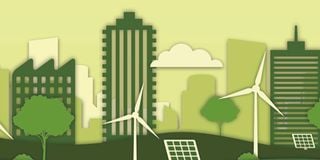Premium
Lessons from Kigali on how Nairobi can restore its green spaces

The construction industry is one of the biggest producers of carbon emissions, and professionals in this space have proposed and tried several measures to make buildings adaptable to climate change.
It might be hard to believe, but conversations around the possibility of human activities affecting climate patterns began in the 1800s.
However, the conversations sparked curiosity, rather than concern. In the 1950s, scientists began experimenting and producing data-backed “claims” that indeed, climate change was real. But it is only in 1988 that this conversation made it to front page news. The term was global warming, not climate change yet. And even then, it still seemed far-fetched.
Today, countries around the globe are feeling the impact of climate change; never-ending high temperatures, drought, floods, locust invasions, extinct insect species, swelling rivers…the list could go on.
The construction industry is one of the biggest producers of carbon emissions, and professionals in this space have proposed and tried several measures to make buildings adaptable to climate change. But the question remains, just how sustainable are the current green building techniques? And, are all stakeholders on the same page?
This year, The Board of Registration of Architects and Quantity Surveyors' annual CPD seminar focused on the built environment and climate change and what needs to be done to make the built environment sustainable.
The seminar, held on May 18 and 19, attracted over 1,500 professionals and multiple stakeholders in the construction industry with speakers painting a sobering picture of the climate crisis we are in while sharing insightful ideas on how the industry can adapt.
Call for a circular economy
In his keynote address, the Cabinet Secretary for the Ministry of Lands, Public Works, Housing and Urban Development, Zacharia Njeru, touched on the need to adopt a circular economy and focus on recyclable materials to make green buildings sustainable.

Lands, Housing, and Urban Development Cabinet Secretary Zacharia Njeru. Mr Njeru has called on the need to adopt a circular economy and focus on recyclable materials to make green buildings sustainable.
Circular economies revolve around reusing and regenerating materials as a way to reduce waste and pollution. The CS also reminded professionals in the industry to adopt global standards to not only achieve climate-resilient structures but to also ensure buildings are safe.
Read: City green spaces vital
Eco-Architect, Hitesh Mehta, the Director of HM Design, gave a thought-provoking presentation that started with a tour down memory lane. Mehta began following the conversation when experts were using the term global warming.
“We are now in a state of climate emergency. It’s no longer about climate change,” he commented, reminding those present that climate change had claimed lives, livestock and wild animals, as well as led to the loss of property and unquantifiable damage. Mehta also pointed a finger at a growing trend he called “the race for the skies”. “Everyone wants their city to look like Dubai and that is hurting the environment,” he explained.
Nairobi on the spot
With buildings dancing with the clouds, the amount of steel, glass and concrete used to build these skyscrapers amount to thousands of metric tons. Needless to say, these materials emit more carbon during their production process, transportation and their eventual use.
Mehta put Nairobi on the spot, cautioning Kenya’s architects against being complacent in the fight against climate change. Nairobi is home to a myriad of commercial glass buildings, which, as Mehta explained, are unsuitable for the tropics. With so much sun and heat in the city, glass buildings require additional air conditioning which circles back to high electricity usage. Electricity use is one of the biggest contributors to carbon emissions, alongside transport and industrial activities. Residential and commercial buildings also make up the top five list of carbon emitters.

This year, The Board of Registration of Architects and Quantity Surveyors' annual CPD seminar focused on the built environment and climate change and what needs to be done to make the built environment sustainable.
Using images to demonstrate that it is indeed possible to restore and reverse the damage already done, Mehta showed pictures taken before the Covid-19 pandemic and during lockdowns in different cities. It was evident that the air was cleaner when we were indoors, manufacturing, transporting and travelling less.
The eco-architect also demonstrated that it is possible to revert to constructing buildings that do not destroy the environment, using his house as an example, which was constructed and decorated using eco-friendly materials. His conclusion was that Kenyan professionals in construction need to start thinking outside the box to solve the crisis.
Echoing Mehta’s sentiments on the state of Nairobi, Landscape, Dr Sunday Abuje, an architect, presented images with climatic patterns that show how the central zone of Nairobi City has been getting hotter and hotter. Previously, temperatures in this zone had varied patterns, oscillating from cold to warm, but now, they are consistently getting hotter. Abuje observed that as the city evolves, it is losing vegetation cover, which acts as a buffer for climate change.
Abuje further noted that those living in informal settlements are more vulnerable to climate change as their shelters are unable to protect them from the erratic changes in weather patterns. He went ahead and expounded on a number of strategies that would help restore the city. These include distributing green spaces, as opposed to concentrating them in one or two locations, introducing appropriate plant species that can survive the changing climate, and having them in strategic locations and proper zone planning for riparian lands.
Lessons from Kigali
A seminar on making climate change sustainable would be incomplete without a voice from the cleanest city and perhaps the greenest in Africa. In 2013, the Kigali City Masterplan was gazetted. It is a plan set to transform Kigali by 2050 through strategies that will restore wetlands, optimise land use, introduce new economic zones and make the city sustainable to essentially improve the lives of those living and depending on it.
The master plan is to be implemented in phases, and so far, things are going well, as depicted by the city’s facelift and current status as the cleanest in Africa. At the seminar, Benon Rukundo, an Urban Planning Specialist and a member of Rwanda Urban Planning Institute, delivered lessons on how Kigali made its plan work. There was plenty to learn.

Benon Rukundo, an urban planning specialist, is a member, Rwanda Urban Planning Institute.
In comparison, Nairobi is relatively a flat land compared to Kigali which has steep hills and valleys. Some of the steepest slopes are inhabitable. In a way, this topography has been an advantage as it slowed down the pace of development while naturally balancing the scale of natural vegetation and buildings. But one factor Nairobi has in common with Kigali is wetlands within both cities. However, in Kigali, wetlands are a no-go zone. Rukundo singled out one of Rwanda’s wetlands which had previously been an industrial zone but was restored to its natural state.
“We started the transformation process around 2018. The first step was to relocate those who were running businesses around the wetland to an industrial park. We now have natural vegetation there, new plant species plus a recreation park,” he said.
Notably, Nairobi has been trying to restore the Nairobi River for some time now. Perhaps we can learn a thing or two from Rwanda’s success in its clean-up and restoration programmes.
On this Rukundo comments, “It is one thing to clean the river, but another to control pollution. For us, we controlled the pollution from the source. Make sure there is no household waste that goes beyond the household and provide alternatives for waste disposal such that it never ends up in the river. Awareness and sensitisation campaigns are also important. People need to understand why the restoration process is important”.
Everyone is a stakeholder
Another key takeaway is Rwanda’s political system. The structures in public and political institutions have been stabilised.
“When new leaders are elected into offices or appointed, they do not come with new agendas. They are supposed to fit into the City of Kigali Masterplan, whose implementation is everyone’s responsibility. Leaders have to understand the Masterplan first before they move on to assist technical experts in implementing it”.
Beyond the plan to restore and upgrade the city, part of the master plan includes an ambitious strategy to create an artificial lake from the wetland that flows through the city.

Circular economies revolve around reusing and regenerating materials as a way to reduce waste and pollution.
“The plan is to convert that stream into a lake. It is in a prime location that cuts through the middle of the CBD, one of the high-end residential and office locations and cuts through a few informal settlements. The project is yet to start, but the government is planning to convert it into an artificial lake with artificial beaches. Along the banks, there will be entertainment zones, and hospitality facilities such that the informal settlements can transition into economic hubs. The idea is to upgrade the informal settlements and empower those around it.”
These are just bits of the country’s grand master plan, and as Rukundo points out, implementing the first phase has been an impactful learning experience as officials had to learn on the go. As the work progresses, the implementers take note of the challenges and adapt. It has taken multiple stakeholders for things to take shape.
Read: Make Nairobi green again
“Everyone is a stakeholder, from people doing business, living or seeking services in the city. However, there are those who’ve taken up the daily tasks. The government, for instance, has been at the forefront, the citizens have also been cooperative alongside organisations involved in capacity building and financing sometimes.”
To African countries grappling with climate change disasters, Rukundo advises, “Climate change is a reality, and we can adapt and deal with the shocks. We definitely need to restore our cities in the long term, but in the short term, we need to have proper warning systems. We should be able to detect when a disaster is about to hit and make sure we are not caught off-guard. Give people time to prepare and save lives. In the long-term, we need measures to restore our environment.”





